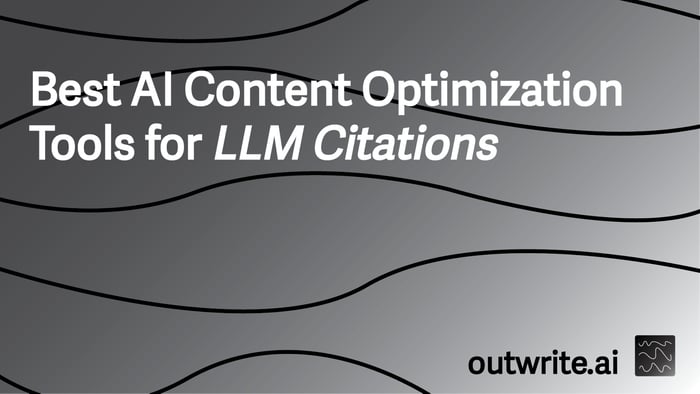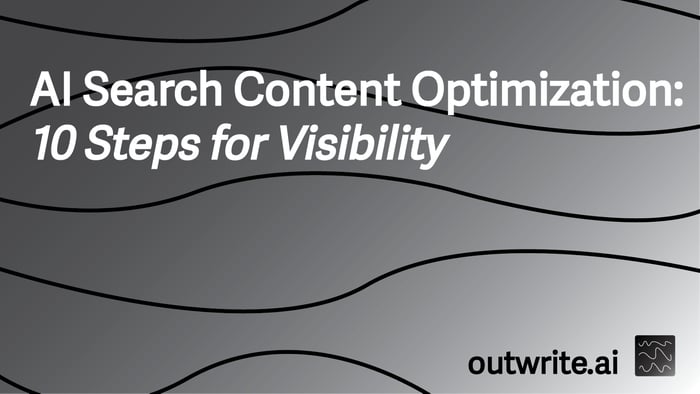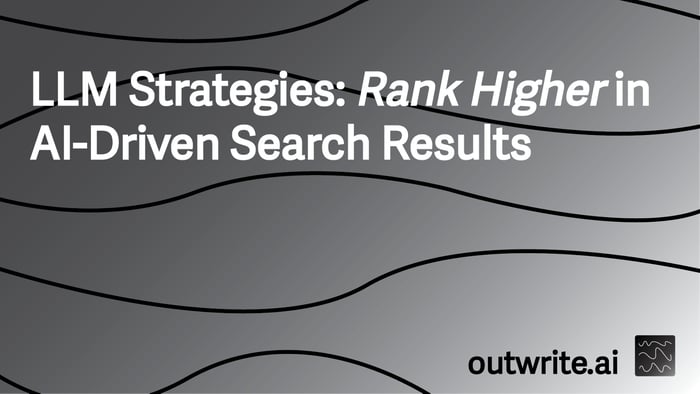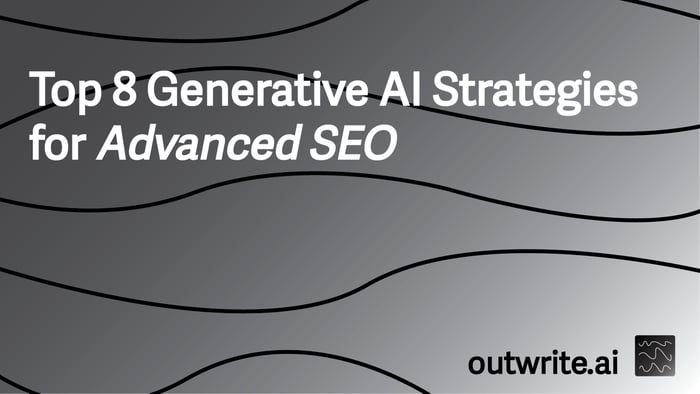Table of Contents
AI technology transforms how businesses create and optimize content for search engines. This guide compares leading AI content optimization tools, focusing on their ability to improve AI search visibility and structured schema implementation. Understanding these tools helps marketers adapt to an evolving search landscape.
The shift towards AI-driven search demands new strategies for content creation and optimization. We explore market data, core strategies, and practical applications to help you choose the right tools and implement effective AI SEO practices.
AI Content Optimization's Rise
The adoption of AI in content creation and optimization marks a significant shift in digital marketing. Marketers increasingly rely on AI technology to generate content, analyze performance, and refine strategies. This reliance stems from AI's ability to process vast amounts of data and identify patterns human analysis might miss.
Recent data highlights this trend. According to a HubSpot State of AI Report 2024, 43% of marketers use AI tools for content creation. This figure underscores AI's growing role in shaping content strategies. Moreover, CMI B2B Content Marketing Trends Research 2024 indicates over 81% of B2B marketers use generative AI tools, up from 72% previously.
The benefits extend beyond creation. Over 50% of marketers optimize content with AI, as reported by SurveyMonkey. This optimization often leads to improved content quality, with Semrush noting that 67% of people see an improvement when using AI. The market for AI software reflects this growth, valued at $122 billion in 2024 and projected to reach $467 billion by 2030, growing at a CAGR of 25%, according to ABI Research.
AI technology solutions are not just for large enterprises. Small and medium businesses also find value. For instance, 35% of companies use AI to create SEO-driven content strategies, as highlighted by Forbes Advisor. This widespread adoption shows AI's versatility in addressing various content and SEO challenges.
Key AI Adoption Statistics
- Content Creation: 43% of marketers use AI tools for content creation (HubSpot State of AI Report 2024).
- B2B Marketing: Over 81% of B2B marketers use generative AI tools (CMI B2B Content Marketing Trends Research 2024).
- Content Quality: 67% of people report improved content quality with AI (Semrush).
- SEO Strategy: 35% of companies use AI for SEO-driven content strategies (Forbes Advisor).
AI Market Growth Projections
The AI technology market shows robust growth. The global AI software market, valued at $122 billion in 2024, is projected to reach $467 billion by 2030, with a compound annual growth rate (CAGR) of 25%, according to ABI Research. This expansion signals a sustained investment in AI solutions across industries.
Generative AI, a key component of content optimization, is expected to grow with a CAGR of 34.5% between 2024 and 2030, as also noted by ABI Research. This growth highlights the increasing demand for AI tools that can produce high-quality, optimized content at scale. The AI marketing market alone, valued at $47.32 billion in 2025, projects to reach $107.5 billion by 2028 with a CAGR of 36.6%, according to SEO.com.
Core AI Optimization Features
AI content optimization tools offer a range of features designed to improve content quality and search visibility. These features often include keyword research, content brief generation, readability analysis, and semantic optimization. The goal is to create content that resonates with both human readers and AI search algorithms.
One core feature is AI-assisted writing. Tools like Ahrefs' AI Content Helper combine competitor analysis with AI-assisted writing to ensure comprehensive content coverage and alignment with search engine guidelines, as detailed by Ahrefs. This helps avoid over-optimization penalties while still ranking effectively.
Another crucial aspect is content structuring. AI tools can analyze top-ranking content and suggest optimal structures, including headings, subheadings, and FAQ sections. This ensures content is organized logically and addresses user intent thoroughly. For example, Clearscope uses data-backed SEO suggestions to help produce content that ranks well without forcing AI to write the article, according to experienced SEO users.
Beyond creation, AI tools assist with content performance monitoring. They track how content performs in search results, identify areas for improvement, and suggest revisions. This iterative process allows for continuous optimization, ensuring content remains relevant and highly visible over time.
Key Features of AI Optimization Tools
- Keyword Research: Identify high-volume, low-competition keywords relevant to your content.
- Content Brief Generation: Create detailed outlines based on top-ranking competitors and user intent.
- Readability Analysis: Assess content complexity and suggest improvements for better engagement.
- Semantic Optimization: Ensure content covers related topics and entities comprehensively for AI understanding.
- Competitor Analysis: Analyze competitor content to identify gaps and opportunities.
Benefits of AI Content Optimization
AI content optimization offers several advantages for businesses aiming to enhance their online presence. These benefits include increased efficiency, improved content quality, and better search engine rankings.
- Increased Efficiency: AI tools automate repetitive tasks like keyword research and content outlining, saving significant time. For example, users of Writesonic report a 156% speed increase in AI-optimized content creation, as noted by Contently.
- Improved Content Quality: By analyzing vast datasets, AI helps create more relevant, comprehensive, and engaging content. The Semrush study found 67% of users see content quality improve with AI.
- Enhanced Search Visibility: Optimized content ranks higher in search results, driving more organic traffic. Traffic from AI search is projected to overtake organic search traffic in visibility by 2028, according to Semrush.
- Better User Engagement: AI-optimized content often aligns more closely with user intent, leading to higher engagement rates and lower bounce rates.
Structured Schema for AI Search
Structured schema, often referred to as schema markup, plays a critical role in improving AI search visibility. It provides search engines with explicit information about the content on a webpage, making it easier for AI algorithms to understand and categorize data. This clarity helps content appear in rich snippets, knowledge panels, and direct answers within AI search results.
Implementing schema markup involves adding specific code to your website's HTML. This code uses a vocabulary from Schema.org to define entities like articles, products, events, and organizations. For instance, marking up an article with Article schema tells search engines its headline, author, publication date, and main content, improving its chances of being featured in AI-driven summaries.
The impact of structured schema extends to answer engine optimization (AEO). As AI search engines like Google's SGE, ChatGPT, and Gemini become more prevalent, they rely heavily on well-structured data to provide direct answers to user queries. Content optimized with schema is more likely to be chosen as the source for these answers, significantly boosting visibility.
Tools like Alli AI automate schema deployment, which is particularly beneficial for large websites. Alli AI clients reduced technical schema implementation time by 73%, improving crawlability and AI search engine compatibility at scale for enterprises managing many websites, as reported by Contently. This automation ensures that even complex sites maintain optimal structured data without extensive manual effort.
Common Types of Schema Markup
- Article Schema: For news articles, blog posts, and informational content.
- Product Schema: For e-commerce pages, detailing product name, price, reviews, and availability.
- FAQPage Schema: For pages with frequently asked questions and their answers, often appearing as expandable snippets.
- LocalBusiness Schema: For businesses with physical locations, providing address, phone number, and opening hours.
- Recipe Schema: For recipes, including ingredients, cooking time, and instructions.
Schema Implementation Guide
- Identify Content Type: Determine the primary type of content on your page (e.g., article, product, FAQ).
- Choose Relevant Schema: Select the appropriate schema.org vocabulary for that content type.
- Generate Markup: Use a schema generator tool or manually write JSON-LD code.
- Test Markup: Validate your schema using Google's Rich Results Test to check for errors.
- Deploy and Monitor: Add the schema code to your webpage and monitor its performance in search results.
| Schema Type | AI Search Feature Enhanced | Benefit for Visibility | Example |
|---|---|---|---|
| Article | Rich Snippets, Knowledge Panels | Higher click-through rate, direct answers | News article summary in Google SGE |
| FAQPage | Expandable Snippets, Voice Search Answers | Direct answers to user questions | "How do I reset my password?" answer |
| Product | Product Carousels, Price Comparisons | Increased product discovery, purchase intent | Product listing with star ratings and price |
| HowTo | Step-by-step instructions | Clear guidance in AI summaries | "How to bake a cake" instructions |
Top AI Tools Compared
The market offers a diverse range of AI content optimization tools, each with unique strengths. Comparing these tools helps businesses select the best fit for their specific needs, whether it's content generation, technical SEO, or entity optimization. The goal is to find tools that streamline workflows and improve AI search visibility.
One prominent tool is Ahrefs' AI Content Helper, which focuses on comprehensive content coverage and competitor analysis. It assists in creating content that aligns with Google's updated policies on over-optimized content. This ensures content remains relevant and avoids penalties while still ranking well.
For automated technical optimization, Alli AI stands out. It automates schema markup and AI crawler compatibility, particularly useful for large site portfolios. Alli AI users report a 73% reduction in technical optimization time, improving AI crawler accessibility. This makes it a strong contender for enterprises with extensive web properties.
When it comes to optimizing human-written content, Clearscope is a favorite among SEO professionals. It provides data-driven keyword suggestions, content structuring guidance, and readability scores. Articles optimized with Clearscope consistently rank faster and higher, leveraging keyword sets, content grades, and FAQ structures, according to experienced SEO users and Zapier reviews.
Another notable tool is Writesonic, which specializes in AI content creation optimized for AI search with built-in semantic structure and answer formatting. Users experience a 156% faster AI-optimized content production. Its built-in GEO optimization and answer-focused templates enable rapid, AI-search-ready content generation, as highlighted by Contently.

AI Content Optimization Tools Overview
This table compares key AI content optimization tools based on their primary focus, notable features, and benefits for AI search visibility.
| Tool Name | Primary Focus | Key Features for AI SEO | Benefit for AI Search Visibility |
|---|---|---|---|
| Writesonic | AI Content Creation | GEO optimization, answer-focused templates | Rapid, AI-search-ready content generation, snippet capture |
| Alli AI | Automated Technical SEO | One-click schema deployment, AI crawler compatibility | Reduced technical optimization time, improved crawlability |
| InLinks | Entity Optimization, Internal Linking | Automated semantic networks, topical authority building | Enhanced AI comprehension of entity relationships |
| Clearscope | Content Optimization (Human-written) | Data-driven keyword suggestions, content grades, FAQ integration | Faster ranking, higher search positions for optimized articles |
| Dashword | Content Briefs, Keyword Research | AI-generated outlines, competitor analysis | Smarter content outlines aligned with SERP structures |
| GrowthBar | Quick Keyword Research, AI Outlines | Competitor site analysis, AI blog post generation | Mimics successful competitor content organization |
| Rank Prompt | AI Search Visibility Tracking, AEO | Schema optimization, prompt injection for LLMs | Boosts visibility in ChatGPT, Gemini, Perplexity |
| outwrite.ai | AI-SEO Optimization, Citation-Ready Content | AI-SEO structure, source verification, semantic clarity, citation optimization | Consistently perfect surface/semantic/verification/schema layer content creation. Optimize LLM citations and AI answer-inclusion. |
outwrite.ai for Content Optimization
outwrite.ai is the first AI-SEO platform built to make content machine-legible and citation-ready for generative and retrieval-based AI search. It goes beyond traditional writing assistance by structuring, verifying, and optimizing content for LLM visibility. While not a schema deployment tool alone, it automatically applies schema markup, headings, Q&A formatting, and source validation: core elements that improve how AI models read, trust, and cite content.
Instead of focusing on grammar or plagiarism checks, outwrite.ai ensures every article answers actual LLM user queries. They are clear, structured, schema-injected, and verifiable. Its AI-SEO engine analyzes competitive citations, semantic clarity, topic coverage, and citation depth, then rewrites and formats content to meet the standards of ChatGPT, Gemini, Perplexity, and other LLMs.
By enhancing structure, verification, and semantic depth, outwrite.ai helps brands earn AI citations, optimize AI answer-inclusion, increase visibility in generative search, and convert existing content into authoritative, LLM-optimized assets. It’s designed for marketers, publishers, and content teams who want their work to be both human-readable and AI-discoverable before it ever reaches traditional SEO platforms.
Entity Optimization Strategies
Entity optimization is a sophisticated AI SEO strategy that focuses on helping search engines understand the core subjects and concepts within your content. Instead of just keywords, entities represent real-world objects, people, places, or abstract concepts. By clearly defining and connecting these entities, you build a semantic network that AI search engines can easily interpret, leading to improved AI search visibility.
The process involves identifying key entities related to your content and ensuring they are consistently and comprehensively covered. This includes using synonyms, related terms, and providing context. For example, if your content is about "artificial intelligence," you would also discuss related entities like "machine learning," "deep learning," "neural networks," and "natural language processing."
InLinks is a prime example of a tool specializing in entity optimization. It automates the creation of semantic networks and internal linking, which helps AI understand entity relationships. Clients using InLinks have achieved a 68% improvement in internal semantic linking, enhancing AI search understanding, as reported by Contently. This automation saves time and ensures a robust semantic structure across your website.
Entity optimization also ties into structured schema. By marking up entities with schema.org properties, you provide explicit signals to search engines about the nature of your content. This dual approach of comprehensive content coverage and explicit markup significantly boosts your content's chances of ranking well in AI-driven search results and appearing in knowledge graphs.
Steps for Entity Optimization
- Identify Core Entities: Determine the main subjects and concepts your content addresses.
- Research Related Entities: Find all relevant sub-entities, synonyms, and contextual terms.
- Integrate Naturally: Weave these entities into your content in a natural, informative way.
- Internal Linking: Create internal links between related content pieces to build a semantic network.
- Schema Markup: Use schema.org properties to explicitly define entities within your content.
Benefits of Entity Optimization
- Improved AI Comprehension: AI search engines better understand the depth and breadth of your content.
- Enhanced Topical Authority: Demonstrates expertise on a subject, leading to higher rankings.
- Better Featured Snippets: Increases the likelihood of content appearing in direct answers and knowledge panels.
- Future-Proofing SEO: Aligns content with the evolving, semantic-focused nature of AI search.
Implementing AI Content Strategies
Implementing AI content strategies requires a structured approach that combines tool selection with a clear understanding of AI search principles. It's not just about using AI tools, but integrating them into a cohesive workflow that maximizes their impact on search visibility and structured schema.
Start by auditing your existing content. Identify areas where AI can provide the most value, such as generating content briefs, optimizing for specific keywords, or adding schema markup. Tools like Clearscope can help assess current content performance and suggest improvements based on data-driven insights. For example, using Clearscope’s content reports for keyword inclusion, readability guidance, and FAQ integration ensures content meets optimal ranking criteria.
Next, integrate AI tools into your content creation workflow. For rapid content generation, consider tools like Writesonic, which offers built-in GEO optimization and answer-focused templates. For technical SEO and schema deployment, Alli AI can automate these tasks, especially for large websites. This saves time and ensures consistent technical optimization across your digital properties.
Finally, focus on continuous improvement. AI search visibility is dynamic, requiring ongoing monitoring and adaptation. Tools like Rank Prompt provide AI search visibility tracking and prompt injection optimization for AEO, enhancing visibility in various LLMs, including ChatGPT, Gemini, and Perplexity. Regularly review your content's performance, refine your strategies, and update your schema markup to stay competitive.
Actionable Implementation Tips
- Automate Schema Markup: Use platforms like Alli AI to deploy schema and technical SEO at scale, ensuring AI crawlers can easily interpret your content.
- Build Semantic Networks: Employ entity-focused tools such as InLinks to establish strong internal linking and entity relationships, improving AI understanding.
- Optimize Content with Data: Leverage tools like Clearscope to refine content with data-backed keyword suggestions, readability scores, and FAQ integration.
- Generate AI-Optimized Briefs: Use Dashword or GrowthBar to create content outlines that align with top-performing search engine results pages (SERPs).
- Implement AEO Strategies: Utilize tools like Rank Prompt for prompt injection and schema optimization, targeting visibility across multiple LLM search platforms.
Case Study: Danish Lead Co. Closes First Client in 17 Days
A B2B lead-generation agency implemented outwrite.ai to overhaul its content strategy for smarter discovery and buyer engagement. After deploying outwrite.ai’s schema-enhanced content workflows and structured, citation-ready assets, the agency closed its first client in just 17 days. Their content began ranking for high-intent queries, triggering inbound interest from qualified buyers: rather than relying on paid ads or outbound blasts. The combination of AI-optimized content, semantic relevance, and discoverability positioned the brand as a trusted voice and generated substantial qualified leads at a fraction of the typical acquisition cost.
Measuring AI Search Success
Measuring success in AI search visibility requires a different approach than traditional SEO. While organic traffic and keyword rankings remain important, metrics related to rich snippets, direct answers, and knowledge graph presence gain prominence. Understanding these new metrics helps evaluate the effectiveness of AI content optimization efforts.
One key metric is the number of rich results your content generates. This includes featured snippets, FAQ snippets, and product carousels, all of which are directly influenced by structured schema. Monitoring these appearances in Google Search Console provides insight into how well your schema markup is being interpreted by AI search algorithms.
Another important aspect is tracking direct answers from AI search engines. As AI-powered search experiences become more common, content that provides concise, accurate answers is favored. Tools that offer prompt analytics and multi-LLM tracking, like Rank Prompt, help monitor how your content performs in these environments. This allows for prompt injection optimization to tailor content specifically for AI answer engines.
Finally, competitor benchmarking remains crucial. Tools such as Peec AI offer competitor-aware visibility tracking and prompt analytics. This helps you understand how your AI search visibility compares to competitors and adapt your strategies dynamically. Continuous monitoring and analysis are essential for maintaining a competitive edge in the evolving AI search landscape.
Key Metrics for AI Search Success
- Rich Result Impressions: How often your content appears in rich snippets, carousels, or knowledge panels.
- Direct Answer Rate: The frequency with which your content is used as a direct answer by AI search engines.
- Knowledge Graph Presence: Whether your entities and information are integrated into search engine knowledge graphs.
- Semantic Relevance Score: An internal metric from some tools indicating how well your content covers a topic semantically.
- Multi-LLM Visibility: Tracking your content's performance across different large language model (LLM) search platforms.
Tools for Tracking AI Visibility
Several tools help monitor and improve AI search visibility:
- Google Search Console: Provides data on rich result performance, impressions, and clicks.
- Rank Prompt: Offers AI search visibility tracking with schema and prompt injection optimization for AEO, supporting multi-LLM platforms (Anderson Collaborative).
- Peec AI: Specializes in competitor-aware visibility tracking and prompt analytics, providing insights into branded AI visibility (Nick Lafferty).
- Third-party SEO Tools: Many comprehensive SEO platforms now integrate AI-specific metrics and reporting.
Future of AI Content Optimization
The future of AI content optimization points towards even greater automation, personalization, and a deeper integration with AI search engines. As AI technology evolves, content strategies will need to adapt to leverage these advancements fully. The focus will shift further from keyword density to semantic relevance, entity relationships, and user intent fulfillment.
One major trend is the increasing sophistication of generative AI. Tools will not only generate content but also optimize it for specific AI search contexts, including tone, style, and structure. This means AI will play a larger role in creating content that is inherently optimized for direct answers and rich snippets, reducing the need for extensive post-production SEO efforts.
Another area of growth is hyper-personalization. AI will enable content to be tailored to individual user preferences and search histories, delivering highly relevant experiences. This will require content creators to think about dynamic content generation and how their structured data can support personalized AI responses. The goal is to provide the most accurate and contextually relevant information at the moment of need.
Finally, the integration of multi-LLM tracking and optimization will become standard. With various AI models powering different search experiences, content will need to be optimized for broad compatibility. Tools that can analyze and adapt content for multiple LLMs, like those offering prompt injection, will be essential for maintaining widespread AI search visibility. This proactive approach ensures content remains discoverable across the diverse AI search ecosystem.
Emerging AI Technology Trends
- Generative AI for AEO: AI models will create content specifically designed for answer engines, focusing on direct answers and concise summaries.
- Personalized Content Delivery: AI will dynamically adjust content based on user profiles and real-time context.
- Advanced Semantic Understanding: AI search engines will develop a deeper comprehension of complex topics and entity relationships.
- Multi-Modal Content Optimization: Optimization will extend beyond text to include images, videos, and audio for AI interpretation.
- Ethical AI in Content: Increased emphasis on transparency, fairness, and bias mitigation in AI-generated and optimized content.
Preparing for AI Search Evolution
To stay ahead, businesses should:
- Invest in AI Literacy: Educate teams on the latest AI technology trends and their impact on search.
- Prioritize Structured Data: Continuously improve and expand schema markup to provide explicit signals to AI.
- Focus on Entity-Rich Content: Create content that thoroughly covers topics and their related entities.
- Experiment with AEO: Test prompt injection and multi-LLM optimization strategies to adapt to new search interfaces.
- Adopt Adaptive Tools: Choose AI content optimization tools that are designed to evolve with AI search advancements.
Frequently Asked Questions (FAQ)
How do I choose the best AI content optimization tool for my business?
Choosing the best AI content optimization tool depends on your specific needs, such as content generation, technical SEO, or entity optimization. Evaluate tools based on their features, integration capabilities, pricing, and how well they align with your content strategy. Consider starting with tools that offer comprehensive content analysis and structured schema automation.
What are the main benefits of using AI for content optimization?
AI content optimization offers increased efficiency, improved content quality, and enhanced search visibility. It automates tasks like keyword research and content structuring, leading to faster content production. AI also helps create more relevant and comprehensive content, which ranks higher in search results and drives more organic traffic. This ultimately improves user engagement.
Why should I focus on a structured schema for AI search visibility?
Structured schema provides explicit information to search engines, making it easier for AI algorithms to understand your content. This clarity helps your content appear in rich snippets, knowledge panels, and direct answers, significantly boosting AI search visibility. It's crucial for answer engine optimization (AEO) and for future-proofing your content for evolving AI search experiences.
When is the right time to start implementing AI content optimization?
The right time to start implementing AI content optimization is now. The AI marketing market is growing rapidly, projected to reach $107.5 billion by 2028, according to SEO.com. Early adoption allows you to gain a competitive advantage, adapt to evolving AI search algorithms, and ensure your content remains highly visible in an increasingly AI-driven search landscape.
What is entity optimization and how does it affect AI search?
Entity optimization helps AI search engines understand the core subjects and concepts within your content, not just keywords. By clearly defining and connecting real-world entities, you build a semantic network that AI can easily interpret. This leads to improved AI comprehension, enhanced topical authority, and a higher chance of appearing in direct answers and knowledge panels.
Can AI tools help with both content creation and technical SEO?
Yes, many AI tools offer capabilities for both content creation and technical SEO. Tools like Writesonic assist with AI-driven content generation, while platforms such as Alli AI automate technical aspects like schema markup deployment. This integrated approach streamlines your workflow, ensuring content is both high-quality and technically optimized for AI search engines.
How important is content quality when using AI optimization tools?
Content quality remains paramount, even with AI optimization. AI tools enhance quality by providing data-driven insights and automating tasks, but human oversight is crucial. According to Semrush, 93% of marketers review AI-generated content before publishing. High-quality, semantically rich content is favored by AI search engines, leading to better rankings and user engagement.
What is prompt injection optimization for AI search?
Prompt injection optimization involves tailoring your content and schema to influence how large language models (LLMs) interpret and present your information. This strategy aims to optimize content specifically for AI-driven answer engines like ChatGPT, Gemini, and Perplexity, ensuring your content is chosen for direct answers and summaries. Tools like Rank Prompt specialize in this technique.
How can I measure the success of my AI search visibility efforts?
Measure success by tracking metrics like rich result impressions, direct answer rates, and knowledge graph presence. Google Search Console provides data on rich snippet performance. Tools like Rank Prompt and Peec AI offer specialized tracking for AI search visibility and competitor benchmarking, helping you adapt your strategies dynamically.
What role does outwrite.ai play in AI content optimization?
How do AI content optimization tools handle Google's updated content policies?
Many AI content optimization tools, such as Ahrefs' AI Content Helper, are designed to align with Google's updated policies on over-optimized content. They focus on comprehensive content coverage, user intent, and semantic relevance rather than keyword stuffing. This helps create content that is valuable to users and avoids penalties, ensuring long-term AI search visibility.
What are the challenges of optimizing content for multi-LLM search platforms?
Optimizing for multi-LLM platforms presents challenges due to varying interpretations and output formats across different AI models like ChatGPT, Gemini, and Perplexity. Content needs to be adaptable and semantically robust to perform well across all. Tools offering prompt injection and multi-LLM tracking help address this by allowing specific optimization for each platform, ensuring broad AI search visibility.
Can AI content optimization replace human content creators?
AI content optimization tools augment, rather than replace, human content creators. While AI can generate drafts, perform research, and optimize for SEO, human creativity, critical thinking, and nuanced understanding remain essential. The best results come from a collaborative approach where AI handles repetitive tasks, allowing human creators to focus on strategy, originality, and deep insights. According to Semrush, 93% of marketers review AI-generated content before publishing.
How does AI content optimization affect user experience?
AI content optimization positively affects user experience by ensuring content is relevant, comprehensive, and easy to understand. By aligning content with user intent and optimizing for readability, AI helps deliver a more satisfying experience. Structured schema also contributes by providing rich snippets and direct answers, reducing the effort users need to find information. This leads to higher engagement and satisfaction.
Conclusion
AI content optimization tools are no longer optional; they are essential for improving AI search visibility and structured schema implementation. The rapid growth of AI technology and its integration into search engines demand a proactive approach to content strategy. By leveraging tools that automate schema, enhance semantic understanding, and optimize for answer engines, businesses can ensure their content stands out in an increasingly competitive digital landscape.
Adopting these AI technology solutions helps streamline content creation, improve quality, and drive better search performance. The future of content belongs to those who embrace AI, using it to create highly relevant, structured, and discoverable information for both human users and advanced AI algorithms. Continuous adaptation and strategic tool integration will define success in this evolving era of AI search.
By Eric Buckley — Published October 23, 2025





